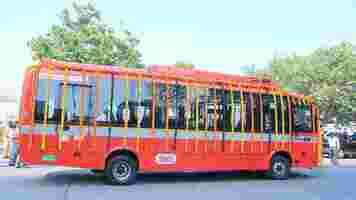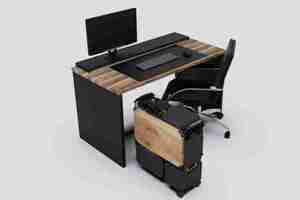Mumbai wants India’s EV crown — and it’s buying 1,900 buses to prove it
Did you know SHIFT is taking the stage on Sept 30 and Oct 1 ? Together with an amazing line-up of experts, we will explore the future of mobility during TNW Conference 2021. Secure your ticket now!

Mumbai, the western city of India, has put out a tender to purchase 1,900 EV buses that will add to its existing fleet of 386. With this, the financial capital of India aims to become the biggest proponent of sustainable public transport.
The Environment Minister of the state, Aaditya Thackeray, made the announcement on Twitter earlier this week. The Brihanmumbai Electric Supply and Transport (BEST), the civic body for transport and electricity based in Mumbai, already runs more than 3,300 buses in the city . With more EV buses being added to the fleet, it would be able to reduce overall emissions.
In July, the state of Maharashtra announced a new EV policy. Under that, it aims to achieve 25% EV-based intra-city transport in Mumbai, Pune, Aurangabad, Nasik, and Nagpur by 2025. It also wants to covert 15% of its 18,000 bus fleet of MSRTC (Maharashtra State Road Transport Corporation) to EVs.
Mumbai is not the only city in India vying to introduce EV buses for public transport. The capital city of Delhi gave a go-ahead of procuring 300 buses in March , and targets to roll them out by November. Plus, it floated a tender for buying 465 additional EV buses.
Other metro cities of the world have also committed to phasing out diesel and petrol-based buses. Last year, Milan bolstered its EV buses fleet by ordering new vehicles. In July, Moscow announced that it will only buy EV buses from now on.
Finally! Someone made a motorbike that looks exactly like a desk
Today, I came across a cool foldable motorbike that looks like a desk, can fit under a desk, but has one big problem: it can’t turn into a desk.



Okay, let’s talk about the bike itself first before I name my reasons why I’d want it to be a desk too.
Built by Japanese startup Icoma , the so-called Tatamel motorbike is made to embody the “free parking wherever you like” concept, according to the company’s CEO.
Admittedly, that’s a pretty good idea if you live in a dense city and you can’t find — or don’t want to pay for — a parking space, or you’re simply reluctant leaving this weird cutie outside.
Performance-wise, it’s not breathtaking, but it’ll do its job . It’s powered by a 600W motor and has an estimated 40km/h top speed and a 50km range on a single charge.
Its battery can, however, charge other devices, so don’t ask for perfection because it’s an unattainable concept anyways.
The bike is still a prototype and there’s no word on a release date yet, but I’m actually GLAD that’s the case.
Because what I really want is for the bike to turn into a desk, and I’ve got some persuasive reasons why Icoma should follow my advice.
1. It’s almost there, people
I mean, if you flip it on the side and attach a structural element to lift it up, then it’s easily doable!
2. It’d be the definition of flexible working
Imagine it’s a hot day and you just can’t stay indoors. You could ride your motorbike to a park and work right on it , while listening to the birds and getting a tan.
3. It’s good for the environment
Not only do you ride an electric vehicle, but you’re also not consuming the precious wood that’d be needed for a normal, separate desk. That’s a double win for Mother Earth.
4. You save money
Do I need to say it? You get two products in one, and that’s a smart budget move.
Overall, is it a perfect motorbike? No, but it’ll have to do. And until the time a motordesk comes, I’ll be dreaming of it.
You can check out all the deets in the video below. You’ll surely agree that my idea is worth considering. In the meantime, I’ll be keeping an eye on my emails for a collaboration proposal from Icoma.
Do EVs excite your electrons? Do ebikes get your wheels spinning? Do self-driving cars get you all charged up?
UK bets on hydrogen for net-zero aviation, but will its plan work?
As part of UK’s FlyZero initiative, the Aerospace Technology Institute (ATI) unveiled on Monday a concept aircraft with ambitions as high as the skies it’s gonna fly to.

It’s a midsize commercial plane, able to carry 279 passengers, and designed for transatlantic flights with one refueling stop or no stop at all. Okay, nothing remarkable here.


But what’s extraordinary is that the concept aircraft is expected to carry out this task using the power of green liquid hydrogen alone. And according to ATI’s press release , the plane would offer the “same speed and comfort as today’s aircraft” but with zero carbon emissions.
Plus, the ATI estimates a whopping range of 5,250 nautical miles — this would mean traveling from London to San Francisco or Beijing without a stop, or to Auckland with just one stop.
The aircraft’s 54-meter wingspan carries two turbofan engines powered by hydrogen combustion.
The fuel is stored in four cryogenic fuel tanks at around minus 250 degrees Celsius: two larger tanks in the rear fuselage and two smaller in the front fuselage.
The smaller tanks keep the aircraft balanced as the fuel burns off and eliminate the need for any additional aerodynamic structures.
Certainly not. And the ATI is well-aware of that, saying we could have the concept aircraft “one day.”
My guess is that we’re years away from this “one day” when we could actually use (long-flight) commercial hydrogen planes. And, in fact, the ATI doesn’t specify how it plans to tackle the challenges associated with hydrogen.
The ATI says that “liquid hydrogen is a lightweight fuel, which has three times the energy of kerosene and sixty times the energy of batteries per kilogram.”
And, indeed, according to the US Office of Energy Efficiency and Renewable Energy (EERE), on a mass basis, hydrogen holds 120 MJ/kg of energy versus gasoline’s 44 MJ/kg.
However, hydrogen has lower energy density by volume: 8 MJ/L versus gasoline’s 32MJ/L, meaning that larger quantities need to be stored to provide the equivalent energy.
This, in turn, translates into the need for larger or more storage tanks which can affect both the capacity and the design of a plane.
As a consequence, aircraft may have to carry fewer passengers to make space for the storage tanks, or become significantly larger.
For instance, ZeroAvia plans to gradually scale up the capacity of its hydrogen-powered planes, with the current prototype, the HyFlyer I , being a six-seater.
Another example is the ZEROe Blended-Wing Body concept aircraft by Airbus, shaped like a large triangle to accommodate the extra-large fuselages needed for long-distance flights with more than 200 passengers.
Using green hydrogen doesn’t come cheap.
It needs to be produced from water through a process called electrolysis , powered by renewable energy such as solar and wind. This process not only requires large amounts of energy, but is also very expensive.
Specifically, according to the management consulting group McKinsey , liquid hydrogen s is more than four times as expensive as conventional jet fuel, and likely to remain at least twice as expensive for the next few decades.
That’s a no brainer. An entirely new infrastructure would be needed to store and transport hydrogen at the airports.
This would be expensive and doesn’t really exist at scale yet.
The FlyZero initiative plans to release more detailed findings early next year, including designs for regional, narrowbody, and midsize aircraft, economic and market reports, technology roadmaps, and a sustainability assessment.
Hopefully, these findings will give us clearer answers.
In the meantime, one thing we can say for certain is that the UK is betting on hydrogen for the future of aviation, although it’s debatable whether this specific tech will mark the industry’s new dawn.
We’re years away from eliminating the challenges related to the use of green hydrogen at such a large scale, and until then it’s possible that batteries or sustainable aviation fuels (SAFs) will have solved the problem of zero-emission flying and hydrogen might not become mainstream at all.